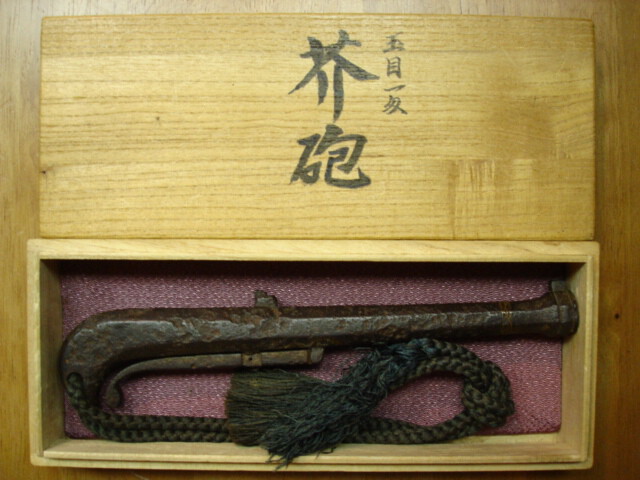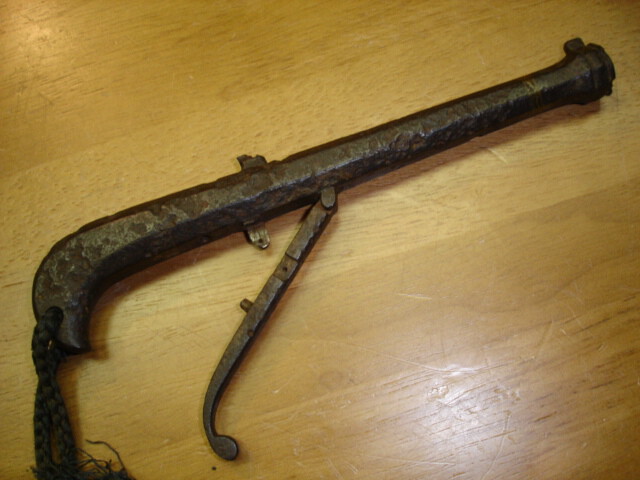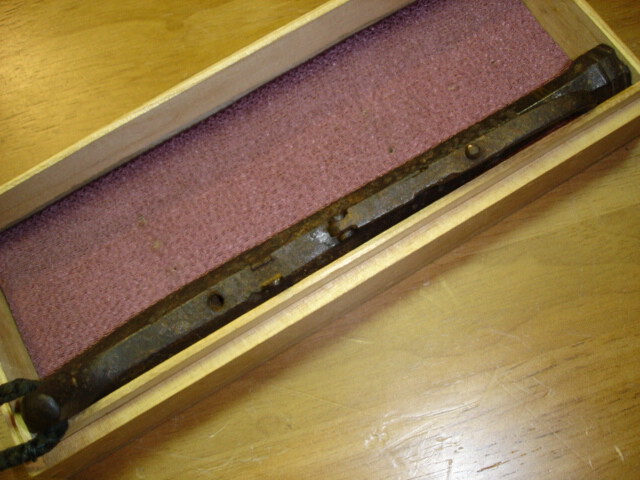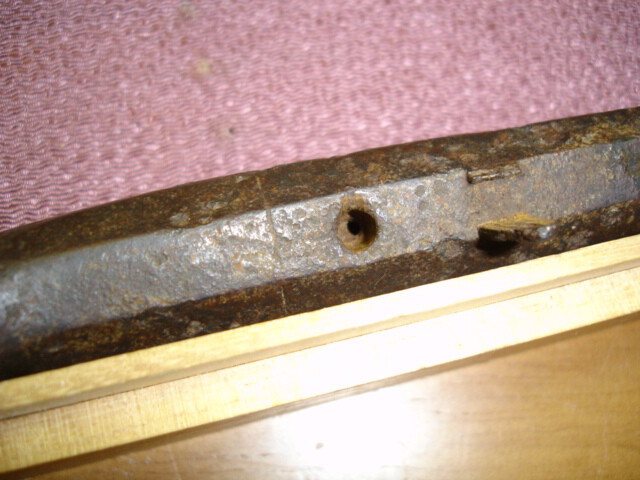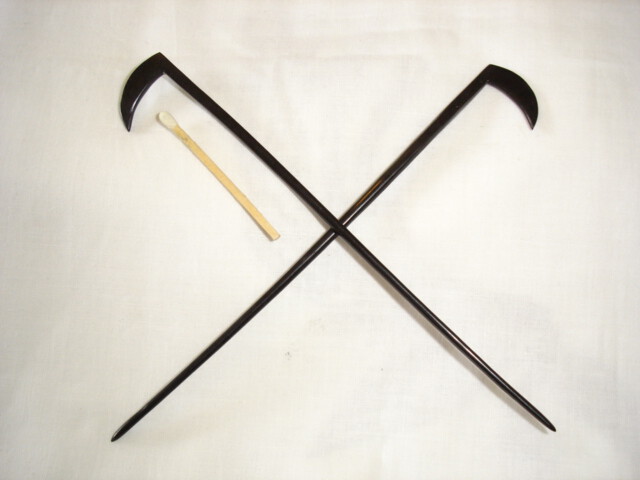-
Posts
14,099 -
Joined
-
Last visited
-
Days Won
262
Content Type
Profiles
Forums
Events
Store
Downloads
Gallery
Everything posted by Bugyotsuji
-
Managed to lose out a couple of times on the auctions, but finally... found a little iron Higo Tanto Tsuba with one hitsu ana opening. It has the Zogan remains of silver Sakura petals all round the Fuchi. The dealer sent it off today, so... tomorrow? Getting quite excited. Let's hope it fits without too much Seppa adjustment. No luck on finding a narrow Kozuka yet, although I have been looking and asking around. They seem to be as rare as*... and even if I found one I am not sure whether it would be within my budget for this project. The Tsuba has eaten up most of that. (*finish the saying! )
-
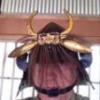
Sword for "left handed Samurai"
Bugyotsuji replied to stephan_hiller's topic in Auctions and Online Sales or Sellers
Samurai walked tending to the left of the roads/paths. Thus the scabbard would never click together with that of a stranger. Even today, knocking shoulders or bumping someone in public is considered the height of bad manners and can lead to violence if the apology is not accepted. For this reason, even if there were indeed left-handed Samurai, (one-armed for example I can understand) they would have been presented with a serious dilemma out of doors, necessitating some special design to get around the carrying problem. -

This Week's Edo Period Corner
Bugyotsuji replied to Bugyotsuji's topic in General Nihonto Related Discussion
Some of our members push tanto through their Do-jime-no-o, and I have toyed with the idea, but as you say, the thought of the saya banging on the Do or crunching under the tightening of the Do-shime is a bit daunting. Most of us have our swords hanging in the Tachi style. Now the lunch idea sounds very good, as long as I can see the collection before or after!!! I used to take my students for three week language courses at Leeds Metropolitan University, Beckett Park Campus, and often wandered around town, but why never to the Armouries? Nuts What I can remember is the mega huge Yorkshire puds with the roast beef roast spuds and gravy inside... and some very nice cold cider... -

This Week's Edo Period Corner
Bugyotsuji replied to Bugyotsuji's topic in General Nihonto Related Discussion
That's a nice site you have found there, Kenji san, based in Saitama I see. Thanks. Ian, this summer I will definitely visit the Royal Armouries on my way up to Scotland!!! (Bought your 1988 book on armour the other day, BTW, and looking forward to sitting down and reading right through it. One question I had. Did all samurai put their swords through their mawashi like that before putting on the 'Do', allowing the Tsuka to appear through the Kusazuri/Gessan odoshi, or only for example the Ashigaru illustrated in the series of pics?) PS Brian, any nice mail recently? -

This Week's Edo Period Corner
Bugyotsuji replied to Bugyotsuji's topic in General Nihonto Related Discussion
Going back into the recesses of my memory, but a Kyushu farmer once told me that they say Karashi for the wild poppies that grow in people's gardens. The character Karashi, Keshi, 芥 can also be read 'Akuta' which means annoying weeds, and is used to describe a plant that is very strictly prohibited and that you are doing your very best to eliminate. PS Nothing to do with the price of fish, but on the subject of plant similarities, :lol: people here in J describe the revolving chamber in a revolver as 'Renkon', which is a lotus root in cross-section. It is interesting that a popular food in Kyushu is 'Karashi Renkon' or lotus root slices stuffed with yellow mustard. -

This Week's Edo Period Corner
Bugyotsuji replied to Bugyotsuji's topic in General Nihonto Related Discussion
Nice article, Henk-Jan. Thanks. many years ago I wrote some papers on Joseph Heco (Hamada Hikozo) who is mentioned as Glover's assistant. Ian, as always, comes through with a good solid follow-up and I get to fill in more holes in my knowledge. Mustard/Poppy seeds, of course! (The words Karashi, mustard or Keshi, poppy are written with the same Kanji as on the box below) I was wondering what the connection with mustard/poppy was in the generic name I mentioned earlier, Kaihou, Mustard or Poppy gun. (Shades of Pepperbox! Especially the seven holed Nigiri-deppo.) The question about burning your hand struck me too. Perhaps they wore leather gloves! The long gun you describe Ian, is still found in Japan, but in very small numbers. I saw and played with one about four or five years ago. They are called Bo-so Raika Ju, and there were several variations. Yours sounds like one of the most evolved examples. Luckily I had my camera in the car yesterday and I ran out to get it. -

This Week's Edo Period Corner
Bugyotsuji replied to Bugyotsuji's topic in General Nihonto Related Discussion
Is everyone familiar with 'Nigiri-deppo' or 'Kaihou'? There was a transitional period between the traditional Hinawa-ju Tanegashima matchlock and the influx of 'modern' Western firearms when all kinds of experiments were being performed in Japan. Many 'Goku-mitsu-ju' were for personal protection or dastardly attack in the turbulent political switchover. The all-weather Nigiri-deppo was a pistol barrel with a parallel lever that you could squeeze to fire a little Raika ball like a Jintan into the chamber. The safety pin held the lever slightly open; pulling the pin meant that you could now squeeze and fire. Well, I have seen several examples of these, in pictures and in real life, but today I saw a genuine one for the first time. There was a boxed one discovered in the Matsudaira family in Takamatsu dated Tempo 11, and there is one in a museum in Tokyo, I have heard. This was another. Apparently they are so rare that 10 or so were made a few years ago to see how they work, and these are generally what people now have in their collections. One of the ways to discover which is genuine is the little hole for the primer ball: it should be 'stepped' or reduced by half inside. Many of the copies do not have this feature. :| -

HI to every one from Smith Forge
Bugyotsuji replied to Smith Forge's topic in General Nihonto Related Discussion
Hi John, Welcome to the site. Did you study in Japan? -
Well, the third illegible Kanji throws the first part of the name (upper two characters) into doubt for me. The lower part of the name is probably the following two characters Kane-hisa, and the final character means something like 'made this'. Look for Kanehisa in your sword books and see if you can find one that might match!
-
All I can see from that photo is
-

This Week's Edo Period Corner
Bugyotsuji replied to Bugyotsuji's topic in General Nihonto Related Discussion
On a simple level, there are two plants there, Hana-Shobu and Yomogi. The Yomogi is great for cuts. I fell off my bike on Monday and cut both hands and my left elbow and knee. Squish up some Yomogi with a mortar and pestle and slap it on. Heaven. Magic stuff. Next morning with minimal bandaging, I dressed in full armor/armour and performed the display without a whimper. The word Moxabustion comes from J Mogusa, another word for Yomogi, a kind of Mugwort. Shobu, a kind of Iris as John said above, with long spiky leaves, symbolizes Victory. These bunches of Shobu and Yomogi are handed out to the visitors to the shrine on Children's (Boy's) Day. Not sure what the symbolic meaning of Yomogi is. Anyway, the wife asked what O-miyage I had from the day and when I presented her with the bouquet, she put it straight into the bath to make it healthy, and smell nice, I guess. -

This Week's Edo Period Corner
Bugyotsuji replied to Bugyotsuji's topic in General Nihonto Related Discussion
In the beginning I used to feel uncomfortable watching my own children bowing at a shrine. I needed to be able understand how to explain to them what might be common between my Western religious background and my wife's Japanese background. I needed to sort myself out first. Through meditation I came to understand that an intelligent power pervades everything. If there is a local god inside the shrine, then he or she will be infused with this greater universal spirit. If there isn't then nothing changes. I bow my head to the larger power behind everything and in such manner find that I lose my fear of how things might look. If I keep my consciousness on that, then I can bow to Mecca, or to Jesus, and there is no sin. Even bowing at a shrine is an opportunity for me to remember what is important. When I got married in a Shinto shrine the Kannushi said to me 'God is everywhere, so these promises you make should be kept." Difficult to argue with that! And then, yes, I am free to enjoy things in the spirit you mention above, John! -

This Week's Edo Period Corner
Bugyotsuji replied to Bugyotsuji's topic in General Nihonto Related Discussion
John, I should have asked you to stand over with Koichi san! Yesterday there was the annual Kobudo-sai at Achi Jinja. We had our bad stuff removed by the Kan-nushi san, and representatives of the different Martial Arts bowed to the main shrines and put on their various displays. Tameshi-giri, Iai, Bo-jutsu, etc. We split into two groups, one in Do-gi and the other in full armour/armor for our display. We were presented with various objects during the day... and at the end I won a huge bottle of Holy Sake. -

This Week's Edo Period Corner
Bugyotsuji replied to Bugyotsuji's topic in General Nihonto Related Discussion
Thems the chaps! Today's puzzle. Last night I found my bath looking like this; can you guess why? A big hand for the right reply. Koichi san probably knows the answer, so could I ask him to hold back for a while? Hint. The question contains a clue. 2nd hint. This is not off topic. -
Pics would be great, whichever way you cut the cake! Thanks.
-

This Week's Edo Period Corner
Bugyotsuji replied to Bugyotsuji's topic in General Nihonto Related Discussion
The two scythes/sickles seem to be Kanzashi for fixing a lady's hair. The bone needle was described as a needle for sewing Kome-dawara, not modern rice sacks exactly, but those cylindrical handwoven rice straw Tawara (Ip-pyo) bales. Is this what you were describing, John? -

This Week's Edo Period Corner
Bugyotsuji replied to Bugyotsuji's topic in General Nihonto Related Discussion
LOL @ Jean. John, you are very close to what was suggested to me... Any further ideas about either before I offer what was suggested? -

This Week's Edo Period Corner
Bugyotsuji replied to Bugyotsuji's topic in General Nihonto Related Discussion
Jean, you could be right on either count. Whale bone sounds good to me. Someone who knows quite a lot about old J customs offered a different suggestion and conferred with an old customer who then agreed with him. -

This Week's Edo Period Corner
Bugyotsuji replied to Bugyotsuji's topic in General Nihonto Related Discussion
Nothing to do with reindeer, I wot, but here are this week's mystery objects. Picked them up at the antiques market, but the seller scratched his head. The two scythes (Length 16 cm) appear to be made of some dark wood, like Shitan or Kokutan? The other is made of... bone? (L 18 cm) Some ideas were suggested as to what they are, but what do you guys think? -

Need help with trans form Sword Paperwork
Bugyotsuji replied to Sus1313's topic in Translation Assistance
The Wakizashi should be 1 shaku 3 zun in length... -

Need help with trans form Sword Paperwork
Bugyotsuji replied to Sus1313's topic in Translation Assistance
Jim, Most of that is fairly easy, and certainly good material for attacking the Japanese language. It is NBTHK Tokubetsu Kicho paperwork from Showa 46, for a Tempo Wakizashi owned by a Rodini (Rodney?) J Henriksen. How much detail do you want? -
Just had some feedback re: 'Sekigane' and 'Ategane'. Although the received literature says Sekigane, the word Ategane has been observed in NBTHK paperwork for Tsuba, regarding for example the reinforcement strips in the photos earlier in this thread. ('Sekigane' is still used for Nakago Ana though.) Apologies to Brian.
-
Rich, point taken, but I have a fundamental dislike of lead, even though I know the Romans used it for plumbing etc. I have to say, however, that I do like the look of both of those Tsuba illustrated above, and the lead is almost forgivable in that wonderfully eclectic scenery. Then I notice that the Sekigane or Ategane? of the hitsu-ana is missing in your Tsuba on the right. Would you be tempted to replace that, knowing that the job is reversible, and it can be removed if ever necessary? PS I can hear you saying "NO! WHY ON EARTH?" :lol: from here...
-
PS What about a Tsuba with the hitsu ana blocked off with lead? I am tempted to take the lead out... :|
-
Had a chat with a Shirogane-shi the other day about this. He collects Tsuba as well. One of his mostly perfect old Tsuba had lost a section of Shinchu flower Zogan, and I asked him if he was considering restoring it. He said that it would be nigh on impossible to get the exact mixture of metal to reproduce the same color/colour as the rest of it. In a word, the colour would always look odd. He is a perfectionist, and to illustrate he showed me an iron Kashira and the gold wing of a tiny sparrow that he has just restored. If you look very carefully, and with advance knowledge that it has been repaired, you can see a faint line in the wing feathers, but I would never have noticed it otherwise. Maybe a good idea to experiment with a hopeless Tsuba to start off!


